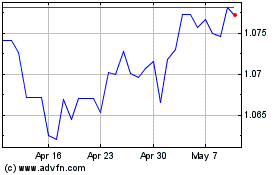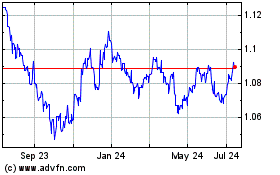Euro Weakens Amid Risk Aversion
April 13 2017 - 1:47AM
RTTF2
The euro declined against its major counterparts in the early
European session on Thursday, as European markets fell tracking
weak cues from Wall Street, amid lingering geopolitical concerns
and Trump's comments on the dollar and interest rates.
Investors digested Trump's comments that the greenback is
getting too strong and he preferred the Federal Reserve to keep
interest rates low.
Oil prices eased for a second day as rising U.S. inventories
stoked worries about global oversupply.
Nervousness over upcoming French Presidential elections also
weighed on the currency, after polls showed a tightening race on
April 23.
The latest Ifop-Fiducial poll on Wednesday showed far-right
leader Le Pen leading centrist Emmanuel Macron by one point to 23.5
percent in the first round on voting.
Final figures from Destatis showed that German consumer price
inflation remained unchanged at a four-month low in March.
The consumer price index rose 1.6 percent year-on-year following
2.2 percent surge in February. The inflation figure was the weakest
since November.
The currency was higher against its major rivals in the Asian
session, with the exception of the Japanese yen.
The euro weakened to a 1-1/2-month low of 0.8475 against the
pound, from a high of 0.8510 hit at 5:00 pm ET. If the euro extends
decline, 0.82 is likely seen as its next support level.
Survey data from the mortgage lender Halifax and IHS Markit
showed that U.K. house prices increased at the slowest pace in four
years in the three months ended March from a year ago.
House prices climbed 3.6 percent year-over-year in the first
quarter, slower than the 6.5 percent spike in the fourth
quarter.
The euro fell to 115.93 against the yen, 1.0679 against the
franc and 1.0642 against the greenback, off its early highs of
116.45 and 1.0698, and a weekly high of 1.0678, respectively. The
next possible support levels for the euro are seen around 113.00
against the yen and 1.04 against both the franc and the
greenback.
The common currency slid to 9-day lows of 1.4019 against the
aussie and 1.5199 against the kiwi, from its prior highs of 1.4178
and 1.5306, respectively. The euro is poised to find support around
1.38 against the aussie and 1.50 against the kiwi.
Reversing from an early high of 1.4137 against the loonie, the
euro slipped to 1.4074. On the downside, 1.39 is likely seen as the
next support level for the euro-loonie pair.
Looking ahead, Canada new housing price index and manufacturing
sales data, for February, U.S. PPI for March, U.S. weekly jobless
claims for the week ended April 8, U.S. University of Michigan's
preliminary consumer sentiment index for April and U.S. Baker
Hughes rig count data are slated for release in the New York
session.
At 10:00 am ET, Bank of Canada Governor Stephen Poloz is
expected to testify along with Senior Deputy Governor Carolyn
Wilkins before the Standing Senate Committee on Banking, Trade and
Commerce, in Ottawa.
Euro vs US Dollar (FX:EURUSD)
Forex Chart
From Mar 2024 to Apr 2024

Euro vs US Dollar (FX:EURUSD)
Forex Chart
From Apr 2023 to Apr 2024
